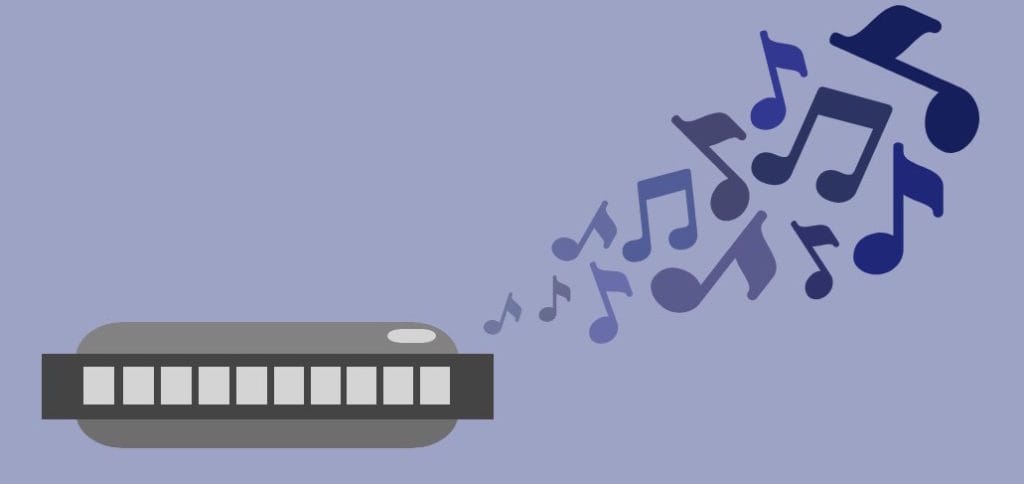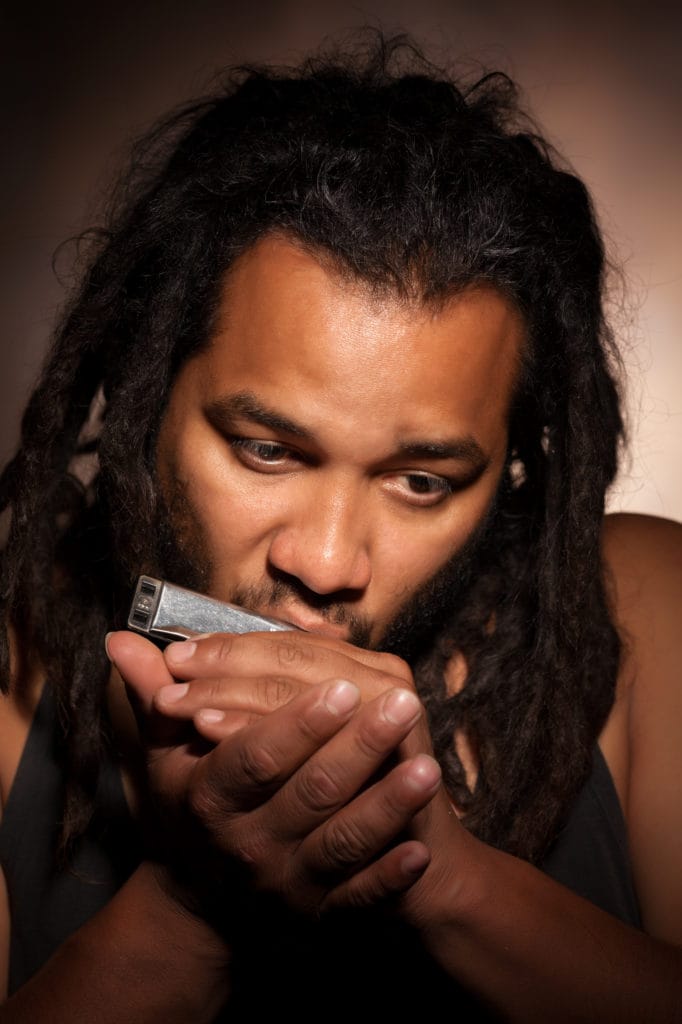When you start playing harmonica, you probably have some inspirations in mind. The way your favourite harmonica player sounds has moved something inside you, and you are motivated develop your own unique sound, too.
The harmonica is, by nature, a very expressive instrument – with hundreds of possible techniques at your disposal, you can make the harmonica sound shrill, bright, warm, melancholy, tense, jubilant, or anything in between. In fact, it’s even possible to “speak” through your harmonica, by enunciating syllables at the start of a musical phrase.
But before you can put all the possible techniques to use to create your sound, you need to have an ear that can recognize these techniques, hear how they’re used together, where they sound good, and how to incorporate them into your playing in a way that is deliberate and musical.
So let’s talk listening skills – and how they are the key for any harmonica player to develop the sound they desire. By understanding what your favorite harmonica players do, you can use their style as a starting point for developing your own style, incorporating the best aspects of your heroes.
What makes a harmonica player’s sound unique?
If you are like most people, you most likely think of sound as a product of the equipment a specific harmonica player is using – I find that this view is especially common among beginner harmonica players.

Although equipment does play a role in shaping your sound, it’s far less important than you might think. Don’t get me wrong – harmonicas, amps, and microphones in different combinations all contribute to the final sound, but unless the initial acoustic sound is good, you will only amplify bad sound. Also, don’t you want to sound good in a purely acoustic setup?
So what’s the key ingredient that really shapes the sound of the harmonica?
It’s really all about the harmonica player’s unique style – how they use note presentation, phrasing, rhythm, embouchure, and structure to build up a song. And these skills are equally useful for both amplified and acoustic playing.
Unfocused Development vs. Focused Development
 As you develop as a harmonica player, you will be continuously listening to harmonica players you admire. By doing so, you are subconsciously internalizing what they are doing, and some of it will make it into your own playing style and harmonica sound. I call this unfocused development. The drawback of this approach is that you will have no control over what you incorporate, or if it is technically correct.
As you develop as a harmonica player, you will be continuously listening to harmonica players you admire. By doing so, you are subconsciously internalizing what they are doing, and some of it will make it into your own playing style and harmonica sound. I call this unfocused development. The drawback of this approach is that you will have no control over what you incorporate, or if it is technically correct.
Shifting your approach from unfocused to focused development, and learning to control your sound, starts with ear training.
Ear training is the perfect tool to sharpen your listening skills so that you can distinguish between the different sounds you hear and break down how they are produced. By doing this, you can actively choose what you incorporate, and even tweak to fit the sound you want. The first level is to really hear the different sounds and nuances, the second step is to understand how the sounds are produced and the final step is to be able to produce the sound and compare it to the original. You cannot play what you cannot hear – it is as simple as that.
What To Listen For
Now that we know the “what” of listening to harmonica playing, let’s look at the “how”.
Earlier, I mentioned a number of musical building blocks that make up the sound of a harmonica player: embouchure, phrasing, rhythm, and so on. To really go deep with your active listening and ear training, you need to listen to a lot of songs by the player you are analyzing and make notes on what you hear.
A great way of doing this is to use a worksheet that makes it easy to take these notes, where you list out the techniques being employed. What you need to note is if a technique or building block is used “always”, “sometimes”, or “never” – but you might also notice some nuances to make a note of. The worksheet can also be downloaded as a free PDF.
To get you started, here are some building blocks you should listen for, and some factors to think about and note down in your worksheet. As you advance, you’ll notice more of your own and your ear will learn to tell the difference!

Embouchure
Most great harmonica players use the tongue blocking embouchure most of the time. It may be interesting to notice if and when the player switches to puckering instead. If the player mostly uses puckering, then how are chords incorporated?
Note Presentation
Clean notes are single notes played without any air being blown into the adjacent holes, creating a monophonic, “clean” sound. In contrast, dirty notes are a main note played with a smaller amount of the adjacent holes played simultaneously. Learn to hear the difference between the two, and the feeling that each lends to the music being played.
Chords, meanwhile, are a set of three notes (or more!) sounded at the same time. Remember that there is a fine line between a chord where holes 2, 3, and 4 are played simultaneously, and a dirty note where hole 3 is the major note being played with some degree of holes 2 and 4 played as well.
Octave splits describes two notes that are three holes apart being played simultaneously to form an octave, for example holes 5 and 8. If the harmonica is very well in tune you really have to listen deeply to spot that it is an octave split and not just one hole played stronger.
Fake splits, meanwhile, are splits that are not true octaves. For example, holes 2 and 5 played simultaneously is a minor seventh.
Musical Effects
 Flutter is a technique where the tongue lets part of the chord sound below the note being played.
Flutter is a technique where the tongue lets part of the chord sound below the note being played.
Tongue slap describes a technique where the full chord is played very briefly before being shut off by the tongue so that only the melody note is played.
Pull slap, similar to a tongue slap, describes a technique where all notes are first blocked before a very sharp tongue slap is performed.
Articulations are notes or chords started by articulating syllables such as “ka”, “ha”, “do”, “yah” or similar.
Tremolo lends a “trembling” effect to the music. On the harmonica, it can be done by either by the throat or by the hand.
Vibrato, or the alteration of pitch by pulses, can be done by gut, throat, or hand.
Phrasing
Musical phrasing is the art of grouping notes in different ways to add interest to the music you’re playing. It’s often inexact and highly instinctive, making it a big part of what makes your harmonica playing sound expressive.
When listening to the music, note the short phrases, long phrases, and everything in between. On which beat is a phrase started? Is it always on beat one?
Rhythm
Take notice of whether there is a steady rhythm, or if the notes dance around the beat. Are notes played on the beat? Or are they swinging? Are chords used to create a rhythm with the melody?
Tension
Tension and release play a big role in music – and there’s various ways that harmonica players achieve this. Picking out the individual notes that create this tension is a more advanced skill that will come with time – but as you hear more and more chords and scales, it will slowly become second nature.
Chord tones are the notes present within certain chords, used in conjunction with chords to create this tension. Take note of how chord tones are used in harmonica playing.
Scale tones, similarly, are the notes present in a specific scale, which all have a distinctive relationship to the tonic. Take note of how these scale tones are used for tension and resolution.
Blue notes are notes played at a non-standard pitch, usually pitched a semitone or a quartertone off the usual pitch. This gives them their “worried” feel.
Structure and Repetition
Phrases are put together in sequences to create passages of music. Listen for how phrases are repeated. Common patterns are AAA, AAB, and ABAC.
Backup Playing vs. Solos and Fills
Is the harmonica playing during vocal phrases? How is that done? Are fills (riffs between vocal phrases) used?
Analyzing the Greats
Let’s look at some famous harmonica players’ styles. Keep the techniques discussed above in mind, and listen carefully for their appearance.
Sonny Terry
Sonny’s characteristic, expressive playing uses a myriad of techniques. Here are some that you’ll encounter in “Whoopin’ the Blues”:
- A lot of rhythmic phrases with whoopin vocalizations
- Often uses partial chords and dirty notes
- Often use 3-hole splits (actually a partial chord)
- Never uses octave splits
- Uses many hand effects
Sonny Boy Williamson II
Listen to “Eyesight to the Blind” and take note of Sonny Boy’s style:
- Tongue block player
- Squeezes the tone to make a sharper, thinner tone than usually associated with tongue blocking
- Often uses pull slapping in triplet phrases
Little Walter
“My Babe” showcases the player’s technique at its finest:
- Tongue block player
- Start phrases on beat 2 more often than most players
- Plays repetitively and rhythmically as backing under vocal phrases combined with fills between vocal phrases
Developing Your Harmonica Sound
To develop your harmonica sound you must first understand what it is that you like – is it rhythmic playing, long phrases, fast tongue slap phrases, or something else? When you know what you like, you can start developing that technique yourself and incorporating it into your playing.
Here’s how:
- Break the technique down into its components, so that you understand how to perform it.
- Form an ideal sound in your head of how the technique should sound.
- Play the technique, and compare it to the sound you have imagined. When repeated over time, you will be able to perform the technique better and better.
- When you can perform the technique in isolation, put into context. That is, use it in a song or phrase you know well, and experiment with how you use it.
All of these steps are, of course, then done for each of the techniques you have identified to be included in your sound. Start with one or two, and let them sink into your playing. Try to overuse them in the beginning, until they are a part of what you normally do.
Sharpening Your Listening Skills
The bottom line: In order to understand, replicate, and build on what you hear your favorite players do, you need good listening skills. What I described above for learning new techniques is a good way of building your mental model of the harmonica while you start understanding how different techniques sound.
In particular, ear training for recognizing intervals is very valuable. It will help you understand the layout of the harmonica and the sound you can expect to hear with various hole combinations. It makes it easier for you to make the connection between the sound of a root note and any note above or below. And best of all, it’ll get you on the fast track to learning your favourite songs, improvising, and even composing your own music.
So get those ears in tune and make them work in your favor!
The harmonica is a fantastic instrument for improvisation and elaboration. To this end, the most valuable thing you can do as a harmonica player is train your ears to pick out notes, chords, intervals, and of course, the multitude of techniques at your disposal – and watch your playing improve.
The post Listening Skills: The Key to Developing Your Harmonica Sound appeared first on Musical U.
